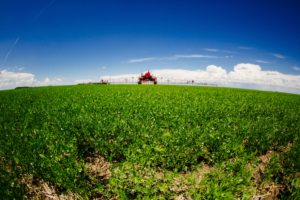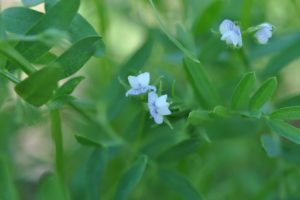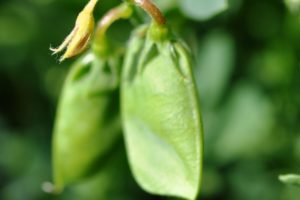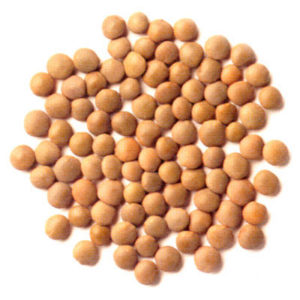Lentils
What are lentils?
Lentils are a pulse crop that is part of the legume family. The word “pulse” comes from the Latin word puls, meaning potage or thick soup. Pulses are the dry edible seeds of pod plants and are high in protein and fibre and low in fat.
The common cultivated lentil is botanically classified as Lens culinaris L or Lens esculenta. Alberta produces two major groups of lentil: A Chilean type (large-seeded) and a Persian type (small-seeded). Other niche markets include red-split lentil, zero-tannin lentil and small black (Indian Head) lentil. Lentils are primarily used for food with only a relatively minor amount used as livestock feed. The two main market classes of lentil are the green and red types. Green lentil is usually marketed as a whole seed, while red lentil is marketed as whole seed or in dehulled and split form. The majority of world lentil production and trade is in red lentil. (https://www.sciencedirect.com/topics/food-science/lentil).

Where do lentils grow?
Lentils are a cool season crop and are grown across the province, but primarily in the south.
In 2019, Alberta’s pulse growers grew 162,600 metric tonnes of lentils on 374,200 acres, with total farm cash receipts of $65.5 Million. Alberta’s lentil exports were valued at $90 Million with the majority of Alberta’s lentil crop exported to India ($55.6 Million) and Sri Lanka ($10.3 Million). The remaining countries purchase significantly less – Pakistan, Colombia, Turkey, United Arab Emirates, Algeria, Egypt, Malaysia, Ecuador and others. As a food crop, Canada has the majority of world production, followed by India, Australia, Turkey and Nepal. (Source: Alberta Agriculture and Forestry, Economics and Competitiveness Branch).

Consider growing lentils if …
- You live in Southern Alberta, Central Alberta, or the Peace River Region.
- Your soil pH is between 6.0 and 8.0.
- You’re growing in the Dark Brown or Thin Black soil zones.
- You do not have high levels of flooding or salinity in your fields.
- You’re interested in marketing flexibility that includes markets for human consumption (including fractionation), and animal consumption when the product grades lower than Canada No. 3.
- You want to reduce your input costs (as pulses are nitrogen fixing); break disease cycles in your field; obtain a second-year yield boost in other crops following a pulse crop; improve your soil health; promote soil conservation and sustainable farming practices; and improve farm profitability.
WATCH THIS VIDEO: Exploring How Lentils Are Grown and Their Sustainability Attributes
Source: Lentils.org
Description
Lentil is a bushy annual plant known for its lens-shaped seeds with a range of seed coat colours from grey or pale green to brown. The cotyledons can be as yellow, green or reddish orange. Lentil plants are typically short but can range from 20 to 75 centimetres (8 to 30 inches), with a relatively shallow root system (0.6 metres or 1.97 feet). The lentil cotyledons remain under the ground after germination. The first two nodes on the stem develop below, or at the soil surface and are known as scale nodes. (See the Lentil Staging Guide and Growth Stages Diagram. The third node on the steam is the usual site of the first leaf development. Lentil seedlings can produce a new node every four to five days under good growing conditions.
Leaf Structures
Leaves are about 5 cm long (just under 2 inches), with 9 to 15 leaflets. Stipules, much smaller than leaflets, occur in pairs on either side of the leaf axis where it joins the stem. Just prior to flowering, new leaves will develop a short tendril at the leaf tip.
The lentil plant usually has two or more secondary branches rising from the main stem. The majority of crop yield comes from branches from the uppermost nodes of the main stem, below the first flower node.

Reproductive nodes (flower)
Lentil flowers are self-pollinating, and can be white, lilac or pale blue. Early maturing varieties flower at the 11th or 12th node stage and later maturing varieties at the 13th or 14th node stage. Flowers appear in clusters of two or three at the base of the upper leaves.
Flowering will be delayed or flowers will abort in high moisture and high fertility conditions. Flowers that form after the first week of August may not produce filled seeds by harvest.

lentil pods
Flower stalks produce one to three flowers, which develop pods. Pods are less than 2.5 cm or less than one inch in length and usually contain one or two seeds.

Lentil Seed Shape & Size
Seed pods are less than an inch in length and contain one to two seeds. Seeds are lens-shaped with a range of seed coat colours range from clear to light green, brown, grey, blotched purple or black, as well as yellow, green or red cotyledons.
Seed size determines lentil type, the Chilean type is larger than the Persian type, with seed size averaging 60-70 grams or higher per 1,000 seeds. The Persian type is small seeded, with seed size averaging 30-40 grams or lower per 1,000 seeds. The two main market classes of lentil are the green and red types.

Adaptation Characteristics
|
Optimal Temperature |
|
|
Frost & Drought Tolerance |
|
|
Type |
|
|
Varieties: |
|
|
Maturity Dates |
|
|
Soil |
|
Stages of Development

The life cycle of the lentil has four principal stages:
- germination and emergence
- vegetative stage
- reproductive stage
- senescence (mature stage)
Resources
History
Lentils are the oldest known pulse crop, and among the earliest crops domesticated in the Old World, having been found as carbonized remains alongside human habitations dating to 11,000 BC in Greece. The lentil was first cultivated in Asia as early as 7000 BC. (Shyam S. Yadav, et al. Lentil: An Ancient Crop for Modern Times”, Springer Science & Business Media 2007.)
The lentil is indigenous to Western and Central Asia. Canada is the leading producer and exporter of lentil. Lentil production in Canada has grown significantly since it began in the late 1960’s, when lentil was initially grown with other legumes as an alternative crop in lieu of fallow. Since 2005-06, Canada has become the largest lentil exporter in the world. (The Canadian Encyclopedia).
Special thanks to Saskatchewan Pulse Growers and Manitoba Pulse & Soybean Growers.
